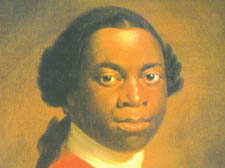|
|
 |
| |

A portrait of Olaudah Equiano. |
Buried in history: the writer who fought to end slave trade
He escaped slavery and campaigned to bring the trade to an end, but hostility from historians means we still don’t know the final resting place of Olaudah Equiano, writes Angela Cobbinah
THE life of the 18th-century freedom fighter Olaudah Equiano reads like an improbable adventure story.
Kidnapped by slavers from eastern Nigeria as a boy in the 1750s and transported to the Americas, Equiano sailed the high seas as a deckhand, gained his freedom and settled in England to become one of the foremost campaigners against the slave trade.
His autobiography, which vividly brought home the horrors of slavery, became an instant best-seller, leaving him both a famous and a wealthy man.
Although he faded from view, interest in Equiano has recently undergone a dramatic revival. Last year, to mark the bicentenary of the abolition of the English slave trade, his portrait appeared on the Royal Mail’s stamp issue commemorating prominent abolitionists and he was the subject of a major exhibition at the Birmingham Museum.
Among the artefacts on display was an original edition of his 1789 autobiography, The Interesting Narrative of the Life of Olaudah Equiano or Gustavus Vassa, The African, which Equiano wrote while living at a number of addresses in the southern reaches of what is today known as Camden.
“Equiano was a typical sailor, he was always on the move,” says historian Arthur Torrington, who helped put the Birmingham exhibition together. “So we don’t know for sure, but he probably began writing Narrative at his lodgings in Baldwins Gardens just off Leather Lane in Holborn.”
Equiano moved into No 53 Baldwins Gardens in 1787, one of a stretch of houses on a site now occupied by St Alban’s primary school.
By this time, he had been in London for 10 years and, in between service on merchant ships to America, he was increasingly involved in the anti-slavery campaign, exposing the Zong massacre, in which 133 slaves were thrown overboard mid-ocean so the owner could claim insurance money.
England was awash with a heady mix of evangelism and political radicalism blown in from revolutionary France, with the Rights of Man becoming a rallying call for both. Slavery came to be increasingly seen as an abomination and a nationwide mass movement was mobilised against it.
Equiano, by now a popular speaker at rallies, wrote a number of letters to the Public Advertiser from Baldwins Gardens on the subject of slavery. Another, written in 1788 to accompany a petition of signatures, was to Queen Charlotte, wife of George III, to draw attention to the “millions of my African countrymen who groan under the lash of tyranny in the West Indies”.
Later that year, Equiano moved to Tottenham Street in what was then in the newly-built suburb of Fitzrovia. Open country lay beyond. Gene Adams of the Camden History Society, speculating on the move westwards, says it may have been because the area was safer and pleasanter to live in than the narrow alleys and courts around his old lodgings, which would one day come to be known as Thieves Kitchen.
Arthur Torrington believes Tottenham Street, and Goodge Place, where he moved to a few months later, were also closer to the offices and hospital of the Committee for the Relief of the Black Poor in Warren Street.
Impoverished blacks, most of them freed slaves or seamen, were a common sight locally and the committee believed a solution to their problem might be to settle those willing in Sierra Leone, West Africa.
“Equiano was appointed Commissary of Provisions and Stores for the expedition and needed to be within walking distance of Warren Street,” explains Mr Torrington.
But it was an ill-conceived plan and Equiano was sacked after making complaints about the sharp practices of some of the other officials.
In 1789, Equiano moved across the parish boundary to Riding House Street in Marylebone, where he completed and published his autobiography to coincide with William Wilberforce’s first abolition debate in Parliament.
The book, one of the earliest of the slave narratives, swiftly became a bible to the abolitionist cause and went through eight editions in as many years. Written in a lyrical and engaging style, it is also a gripping adventure story in which, having been spared the horrors of plantation slavery by the “the hand of God”, Equiano is sold to a naval captain. Taught to read and write, he becomes a skilled sailor and spends the next 30 years travelling the world.
Equiano, by now living with his wife and two young children in Covent Garden, was as skilled a marketer as he was a writer and he toured Britain to publicise the book, spending several months in Ireland where he sold almost 2,000 copies. When he suddenly died in 1797, aged around 55, he left his toddler daughter £950 – roughly £80,000 in today’s money.
Despite his fame and fortune, Equiano was later “airbrushed” from history, says Mr Torrington. “Nineteenth-century historians did not want to see him as a hero and he fell into obscurity. We know the different places he lived at, but we don’t know where he is buried.”
But 200 years on, Equiano’s remarkable story has again captured people’s imagination and he is at last being restored to his rightful place in history.
 |
| |
|
 |
 |
|
 |
|



